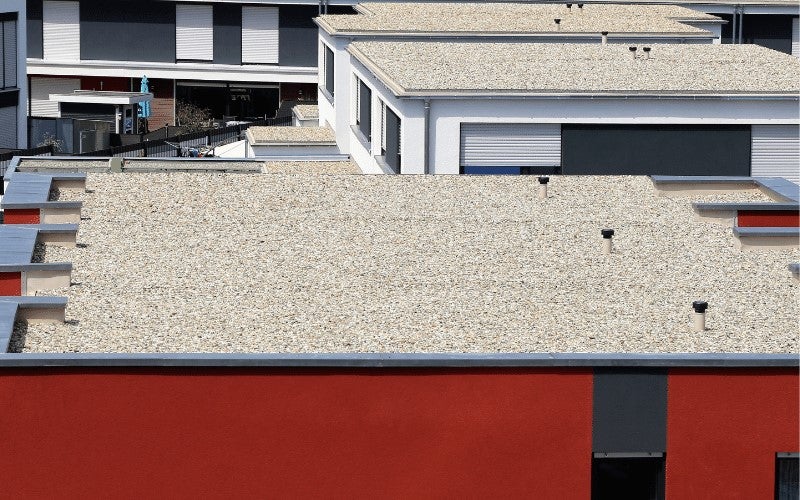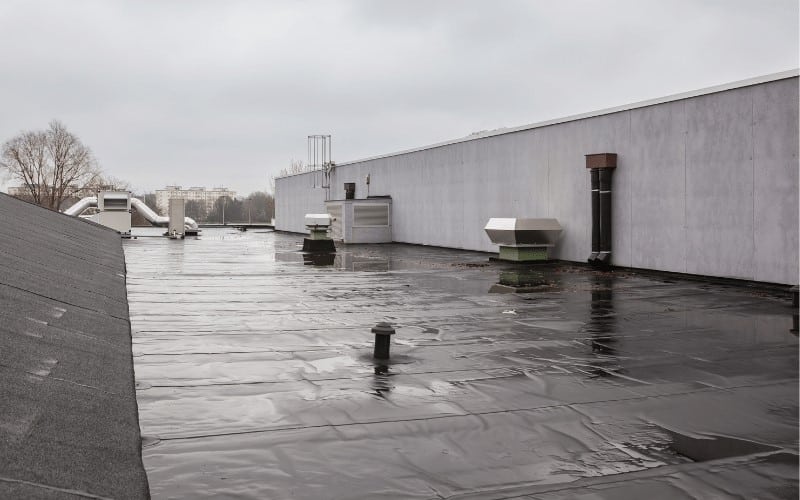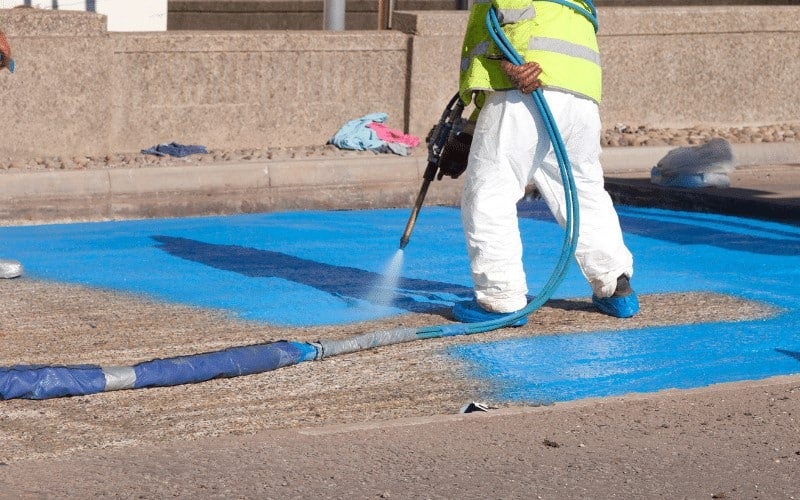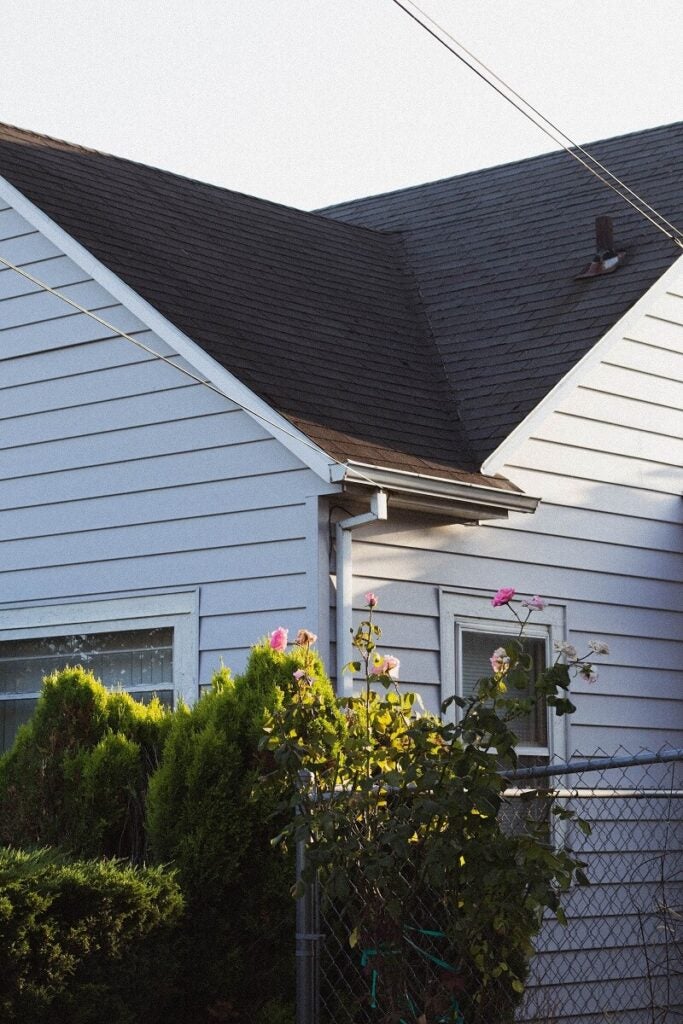If you have a traditional sloped roof on your home, roofing felt and shingles are usually enough to keep rain from entering your house. But if you have a flat or low-slope roof, you might need something different: a roof membrane.
Roof membranes create a waterproof barrier that helps protect your home from water damage. They’re commonly found on buildings with flat or nearly flat roofs, including commercial properties, apartment complexes, and single-family homes. The type of roof membrane you choose will often depend on your area’s climate and how much sunlight your roof receives.
Get help choosing and installing a new roof membrane using the link below:
What Is a Roof Membrane?
Roof membrane is designed for flat or nearly flat roofs to protect the home underneath, helping to move water off the roof and prevent moisture from entering the building.
In most cases, they’re made up of material bought in rolls or squares and installed using adhesive or heat, like in torch-down roofing. You may be able to choose a roof membrane made of asphalt, rubber, or plastic. However, other options include spray foam or liquid-based membranes.
Membrane Roofing Cost
You should budget between $5 and $9 per square foot to install a new rolled membrane on your roof. With a typical home having around 1,700 square feet of roofing, your total cost will likely fall between $8,500 and $15,300.
However, various factors can influence your price, including the size of your roofing system and the type of membrane you need. You’ll also pay more if you need to remove existing roofing materials before installing your new roof. We recommend you read our article to find out our new roof pricing guide.
Roof Size
The size of your roof affects the cost of both materials and labor. This is because roofing materials are typically bought by the square foot. The larger your roof, the more material you’ll need to buy and the longer it will take to install.
Roof Complexity
Roof membrane on a single, flat expanse will be simpler and cheaper to install than a home with different roof surfaces or in a complex design.
Membrane Type
Many membrane types are available, and some are more expensive than others. For example, a rolled membrane is typically the cheapest option, while alternatives can cost more and require more materials and installation time, increasing the overall cost.
What Is the Minimum Slope for a Membrane Roof?
Roof membranes are common on flat roofs, though even these are not truly flat. The minimum slope of a flat roof is ¼ inch of rise per foot, although some insurance companies can require a minimum of ½ inch per foot. This ensures efficient drainage, reducing the amount of pooling water after a heavy rainstorm.
Built-up Roof Membranes (BUR)

This type of roof membrane is commonly known as “tar and gravel” roofing and is common in older buildings. It is typically made up of layers of bitumen (usually asphalt or tar) with reinforcing fabrics or felts between them to create a complete barrier. Each layer is called a “ply,” and there are usually three or more plies in a built-up roof membrane. You can buy the membrane materials in rolls, which are glued down or applied using a torch.
Modified Bitumen Roof Membranes

These roof membranes are similar to a built-up roof membrane but made with slightly different materials engineered to improve elasticity and strength. In many cases, they can be installed by peeling and sticking.
Styrene-Butadiene-Styrene (SBS) Membranes
This type of modified bitumen roof membrane is made of synthetic rubber. This material can retain its shape after being stretched. Benefits of SBS membranes include:
- Compatibility with all types of flat roofs
- Ability to withstand severe weather conditions
- Simple installation
Atactic Polypropylene (APP) Membranes
Atactic polypropylene-modified bitumen membrane is made using a type of plastic. It’s designed to be flexible and difficult to puncture.
Benefits of APP membranes include:
- Better UV resistance
- Ability to withstand rapid temperature changes
- High tensile strength, making them hard to crack
Single-Ply Membranes

Unlike bitumen-based roofing membranes with multiple layers, a single-ply roof membrane is made of a single layer of synthetic roofing material that creates a waterproof seal. This can make single-ply membranes cheaper and easier to maintain. However, they can also be easier to puncture and don’t withstand foot traffic as well.
Single-ply roof membranes are typically purchased in rolls and sealed at the joints using heat or adhesive.
Thermoset Membrane Roofing
This is a type of synthetic rubber roofing that’s often used for commercial roofing. The coating combines ethylene and propylene materials made from oil and natural gas. Thermoset roofing can withstand high temperatures, holding its shape even when heated.
EPDM Roofs
EPDM stands for ethylene propylene diene monomer and is a common type of thermoset membrane roofing. EPDM roofing consists of synthetic rubber that’s durable and heat- and weather-resistant.
Thermoplastic Membrane Roofing
Thermoplastic membrane roofing is a type of single-ply membrane made from synthetic materials. As opposed to thermoset materials, thermoplastic membrane roofing systems soften when exposed to heat, meaning they can be reshaped and recycled.
PVC Roofs
Polyvinyl chloride (PVC) is a durable thermoplastic single-ply roof membrane that’s particularly resistant to oils and grease. This makes PVC roofing membranes an ideal material for kitchens and manufacturing facilities.
KEE Roofs
Ketone ethylene ester, or KEE, is another common thermoplastic roofing membrane material. It’s known to be flexible and durable.
Spray Polyurethane Foam (SPF) Roof Membranes

SPF is made from heated and pressurized chemicals, formed into a liquid that expands into a foam to create a solid layer across a roof.
Benefits of SPF roof membranes include:
- Highly durable
- Waterproof
- Seamless
- Energy-efficient
Liquid Applied Roof Membranes

This membrane material is a liquid-based roof coating with a rubber-like consistency that can be used over asphalt, bitumen, or concrete.
It’s a popular choice for commercial buildings because it’s cost-effective and seamlessly fills in cracks, voids, and gaps. It’s also ideal for exposed roofs with numerous complicated features.
Related: Castagra Review
Final Thoughts
If you have a flat roof or one with a low slope, you’ll almost certainly need a roof membrane — but your options are numerous. As you decide which type of roofing material works best for you, keep a few things in mind:
- How much sun does your roof get?
- What rooms does it cover?
- Will you need to walk on it regularly?
- How visible is the roof?
- How much severe weather do you expect?
The answers can help you whittle down your options to find the best one. A roofing contractor can also help you price out your options.
Roofing Contractors for Membrane Roofs
Installing a roof membrane is a big job. Strongly consider hiring a professional for your safety and to ensure the roof membrane is fit correctly and tidily.













